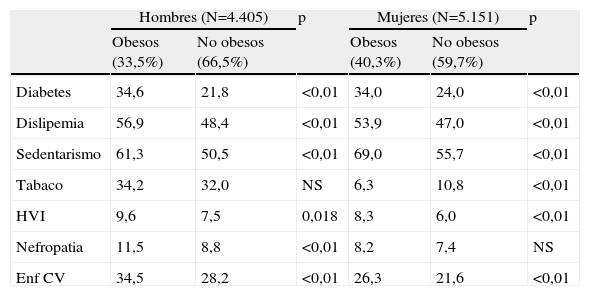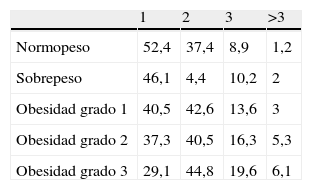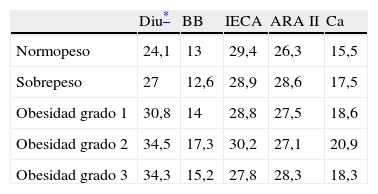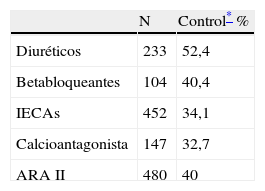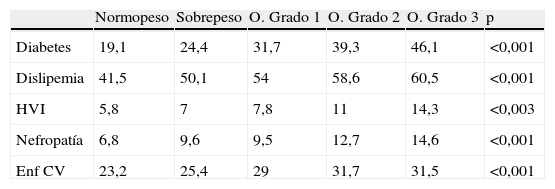Conocer la prevalencia de obesidad en población hipertensa y cómo influye el exceso de peso en su manejo.
MétodosEstudio descriptivo, transversal y multicéntrico realizado en pacientes hipertensos atendidos en consultas de Atención Primaria en España. Participaron 2.850 médicos que seleccionaron a los pacientes mediante muestreo consecutivo. Los criterios de inclusión fueron: pacientes de ambos sexos, de 18 o más años de edad, hipertensos en tratamiento y que daban su consentimiento para participar en el estudio.
Las variables analizadas fueron: peso, talla, índice de masa corporal (IMC), circunferencia de la cintura (CC), presión arterial (PA), factores de riesgo (FR) asociados, actividad física, afectación de órganos diana, y enfermedades cardiovasculares (ECV) asociadas.
ResultadosLa muestra total de pacientes hipertensos analizados fue de 10.520 (53,9% mujeres) con una edad media de 64,6 (DE: 11,2) años. La prevalencia de obesidad según IMC fue del 36.9% (35% en hombres y 40.3% en mujeres) y de obesidad abdominal del 56,4% (40,5% en hombres y 71,6% en mujeres). En los hipertensos obesos, el grado de control de la PA fue del 33,2% y la prevalencia de hipertensión refractaria del 49,2%.
La terapia combinada se utilizaba en el 47,8% de los pacientes con normopeso, en el 53,9% de los que tenían sobrepeso y en el 64,2% de los obesos y la prevalencia de FR asociados, afectación de órganos diana y ECV era mayor en los obesos que en los que tenían normopeso.
ConclusionesLa prevalencia de obesidad en los hipertensos es elevada y condiciona un peor control, mayor riesgo y mayor utilización de fármacos.
To determine the prevalence of obesity in the hypertensive population and how excess weight affects its management.
MethodsA descriptive, cross-sectional, multicenter study was conducted in hypertensive patients in Primary Care in Spain. A total of 2,850 doctors, who selected the patients through consecutive sampling, participated. Inclusion criteria were patients of either sex, aged 18 years or older, receiving treatment for hypertension and who gave their consent to participate in the study.
The following variables were analyzed: weight, height, body mass index (BMI), waist circumference (WC), blood pressure (BP), associated risk factors, physical activity, target organ damage and associated cardiovascular disease (CVD).
ResultsA total sample of 10,520 hypertensive patients (53.9% women) with mean age of 64.6 (SD: 11.2) years was analyzed. Prevalence of obesity according to BMI was 36.9% (35% in men and 40.3% in women), with abdominal obesity in 56.4% (40.5% in men and 71.6% in women). In the obese hypertensive patients, BP control was achieved in 33.2%. Prevalence of refractory hypertension was 49.2%.
Combined therapy was used in 47.8% of patients with normal weight, in 53.9% of the overweight and in 64.2% of the obese patients. Prevalence of associated risk factors, target organ involvement and cardiovascular disease was more frequent in the obese than in those with normal weight.
ConclusionsPrevalence of obesity in the hypertensive population is high and is a determining factor for poorer control and increased risk and use of drugs.







